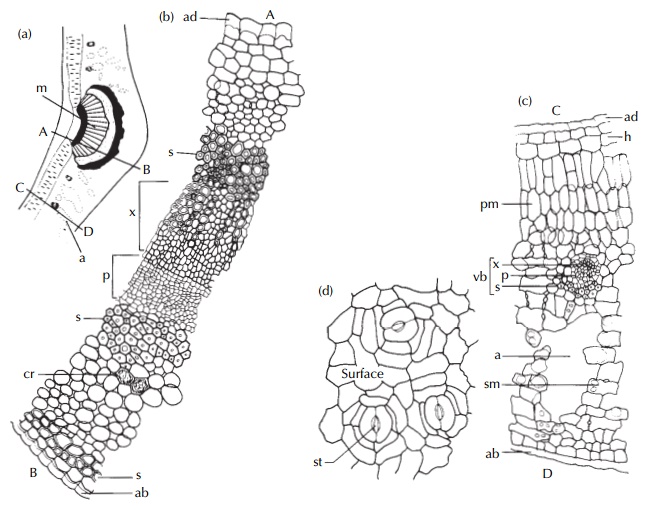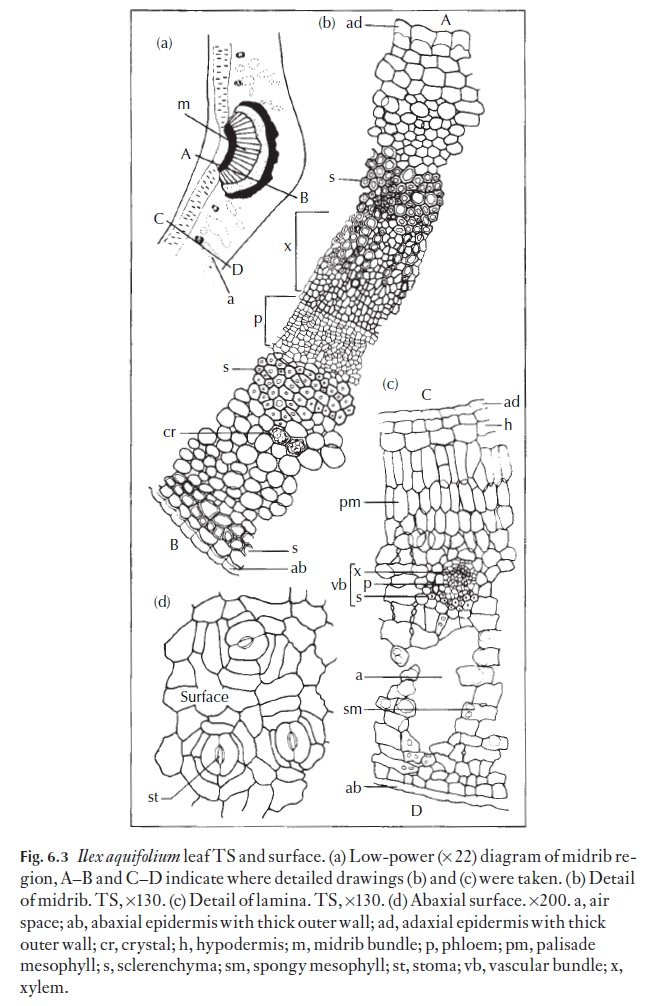Chapter: Plant Anatomy:An Applied Approach: The leaf
Leaf structure - Plant Anatomy

Leaf structure
Many leaves are flattened dorsiventrally. The leaf of Ilex aquifolium, in Fig. 6.3 in transverse section and surface view, serves to illustrate general dicotyle-donous foliage leaf anatomy. In this example, the epidermis forms the bound-ary between the atmosphere and the underlying mesophyll and vascular and non-vascular tissues. Its cells are specialized for this function. Note that the adaxial epidermal cells (Fig. 6.3c) have thickened outer walls. The epidermal cells are covered by a thin cuticular layer. In this dorsiventrally compressed leaf, the upper and lower surfaces are different, as can be seen from Fig. 6.3(a– c). Stomata occur among the cells of the lower (abaxial) surface only; the leaf is thus hypostomatic (see Fig. 6.3d). The mesophyll consists of chlorenchy-matous, palisade-like cells on the adaxial side with few intercellular spaces, and of more loosely arranged spongy cells with larger intercellular spaces on the abaxial side (Fig. 6.3c). Part of the vascular system is shown, including the large midrib bundle (Fig. 6.3a) and in more detail in Fig. 6.3(b). A smaller sec-ondary vein is illustrated in Fig. 6.3(c). In all leaf blade vascular bundles, phlo-em occurs to the abaxial and xylem to the adaxial side of the leaf. The larger and many of the smaller vascular bundles frequently have a cap of sclerenchy-ma cells associated with the phloem pole only.

In general terms, all leaves have similar features – an epidermis with sto-mata, mesophyll and vascular tissue. However, the arrangement of these components is, to a large extent, dictated by the physical environment such as water availability, light intensity, ecological niche and herbivores. Through selection pressure, it is the interplay of these environmental parameters which serves to drive the evolution of leaf structure. The epi-dermis may, for example, be one or more layers thick, there may be either a thick or a thin cuticular covering, there may be a hypodermis associated with the epidermis. Stomatal distribution may be on both surfaces of the leaf or on one surface of the leaf only, and they may be raised above the gen-eral leaf surface, flush with the leaf surface, or in some cases, sunken into crypts. The mesophyll may be specialized or unspecialized. If specialized, a palisade or spongy layer may exist and in some leaves, palisade tissue may exist on both sides of the leaf (isobilateral) as is the case in many succulents. The mesophyll may be compact, with numerous small intercellular spaces as in xerophytes, or may contain a large intercellular space volume, as in some mesophytes and most hydrophytes.
The general mechanical requirements of a typical leaf are thus: (i) ade-quate gas exchange and (ii) functional transport pathways.
Related Topics